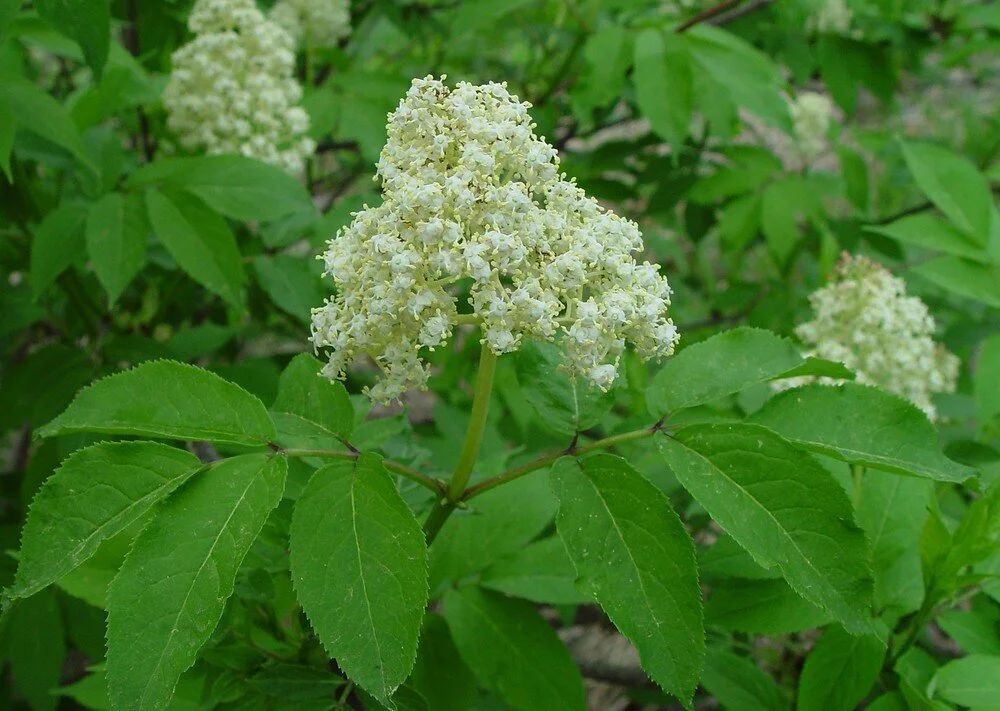Sambucus racemosa (Red Elderberry)
Red Elderberry is a great shrub for landscapes or revegetation projects, as its vase-like form can create a canopy over smaller woodland shrubs. Above its large compound leaves, it produces pyramidal clusters of creamy white flowers in the early summer, and elongated inflorescences of striking red berries from late summer to fall. This is a great shrub for birds, pollinators, and other wildlife!
Best in part sun to shade, Red Elderberry can grow up to 20 ft. tall over a very long time, though usually it’s maintained at a much smaller height, ~6-10 ft. It may require intermittent pruning to maintain a tidy shape in a garden setting.
Red elderberry is best sited in free-draining soils with plenty of organic matter, mimicking the forest conditions in which it thrives. (For sunnier sites and poorer soils, plant Blue Elderberry.)
Red elderberry's fruits can be made into wine or jelly, but not jam or eating the flesh (only the juice can be used, as the seeds are not safe to eat and must be strained out). For an edible elderberry, seek the native Blue Elderberry.
Red Elderberry is a great shrub for landscapes or revegetation projects, as its vase-like form can create a canopy over smaller woodland shrubs. Above its large compound leaves, it produces pyramidal clusters of creamy white flowers in the early summer, and elongated inflorescences of striking red berries from late summer to fall. This is a great shrub for birds, pollinators, and other wildlife!
Best in part sun to shade, Red Elderberry can grow up to 20 ft. tall over a very long time, though usually it’s maintained at a much smaller height, ~6-10 ft. It may require intermittent pruning to maintain a tidy shape in a garden setting.
Red elderberry is best sited in free-draining soils with plenty of organic matter, mimicking the forest conditions in which it thrives. (For sunnier sites and poorer soils, plant Blue Elderberry.)
Red elderberry's fruits can be made into wine or jelly, but not jam or eating the flesh (only the juice can be used, as the seeds are not safe to eat and must be strained out). For an edible elderberry, seek the native Blue Elderberry.
Red Elderberry is a great shrub for landscapes or revegetation projects, as its vase-like form can create a canopy over smaller woodland shrubs. Above its large compound leaves, it produces pyramidal clusters of creamy white flowers in the early summer, and elongated inflorescences of striking red berries from late summer to fall. This is a great shrub for birds, pollinators, and other wildlife!
Best in part sun to shade, Red Elderberry can grow up to 20 ft. tall over a very long time, though usually it’s maintained at a much smaller height, ~6-10 ft. It may require intermittent pruning to maintain a tidy shape in a garden setting.
Red elderberry is best sited in free-draining soils with plenty of organic matter, mimicking the forest conditions in which it thrives. (For sunnier sites and poorer soils, plant Blue Elderberry.)
Red elderberry's fruits can be made into wine or jelly, but not jam or eating the flesh (only the juice can be used, as the seeds are not safe to eat and must be strained out). For an edible elderberry, seek the native Blue Elderberry.


